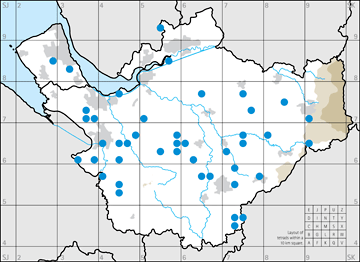
Rook © Steve Round
This is the most rural member of the crow family and the main determinant of its winter distribution in the county seems to be its avoidance of the most built-up areas. As in the breeding season, only 6% of the species’ habitat records were classed as human sites; intriguingly, two-thirds of these were suburban, with few in urban or rural areas. Almost three-quarters (74%) of records of Rooks were on farmland, with the main categories being 42% on improved grassland, 8% unimproved grassland and 6% stubble. Their winter food is mainly seeds, waste root crops and invertebrates, but they scavenge almost anything, and often flock to landfill sites. Many of the 18% of records in woodland can be accounted for by early-returning birds to arboreal rookeries: they refurbish nests from January onwards. Nearly all of the Rooks found in the county in winter will have been local birds: some from farther north in Britain disperse, usually no more than a few kilometres, but this is unusual for most English birds. In some years birds arrive on the east coast from northeasterly and easterly directions, but they seldom penetrate beyond the eastern counties (Migration Atlas).

Rook roost map.
Rooks spend almost all of their lives in flocks. The median size of gatherings reported for this Atlas was 25 birds, with 75 flocks of 100 or more but few (five) gatherings of more than 250. The largest were 600 birds at Maw Green Tip and adjacent flashes (SJ75E), and 400 on stubble near the Gowy Meadows (SJ47M). Larger flocks gather together noisily at night, with 1,000 in Crewe Hall Woods (SJ75H). Roosts were reported in 43 tetrads; although some are shared with other species, especially Jackdaws, the distribution of reported Rook roosts is quite different, with none in the south Manchester fringe or the south of the county.
Sponsored by Anne and Stephen Young

